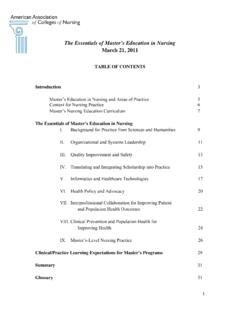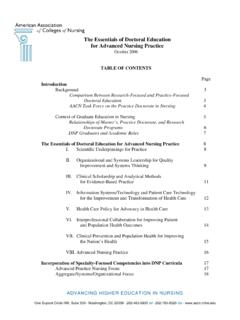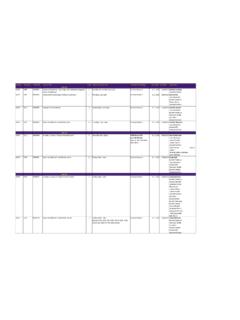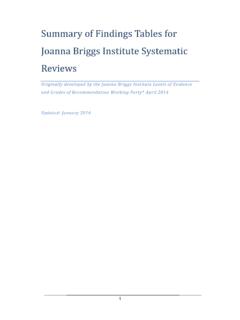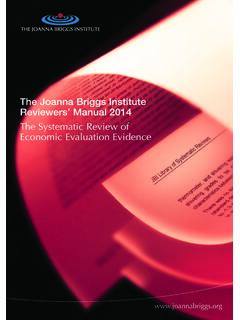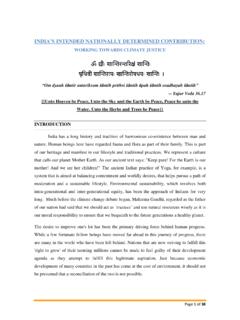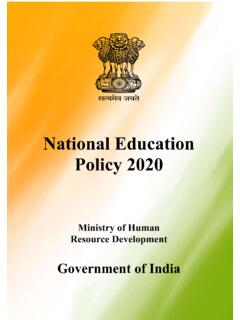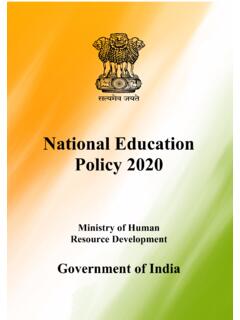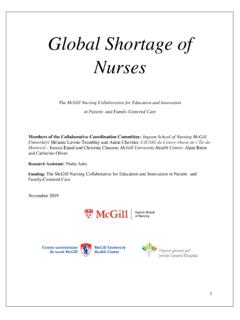Transcription of The Essentials of Baccalaureate Education - School of Nursing
1 The Essentials of Baccalaureate Education for Professional Nursing Practice October 20, 2008 TABLE OF CONTENTS Executive Summary 3 Background 5 Nursing Education 6 The Discipline of Nursing 7 Assumptions 8 Roles for the Baccalaureate Generalist Nurse 8 Preparation for the Baccalaureate Generalist Nurse: Components of the Essentials 10 The Essentials of Baccalaureate Education for Professional Nursing Practice I. Liberal Education for Baccalaureate Generalist Nursing Practice 10 II. Basic Organizational and Systems Leadership for Quality Care and Patient Safety 13 III. Scholarship for Evidence Based Practice 15 IV. Information Management and Application of Patient Care Technology 17 V. Healthcare Policy, Finance, and Regulatory Environments 20 VI. Interprofessional Communication and Collaboration for Improving Patient Health Outcomes 22 VII. Clinical Prevention and Population Health 23 VIII. Professionalism and Professional Values 26 IX. Baccalaureate Generalist Nursing Practice 29 Expectations for Clinical Experiences within the Baccalaureate Program 33.
2 1 Summary 35 Glossary 36 References 40 Appendix A: Task Force on the Revision of the Essentials of Baccalaureate Education for Professional Nursing Practice 45 Appendix B: Consensus Process to Revise the Essentials of Baccalaureate 46 Education for Professional Nursing Practice Appendix C: Participants who Attended Stakeholder Meetings 47 Appendix D: Schools of Nursing that Participated in the Regional Meetings 49 Appendix E: Professional Organizations that Participated in the Regional Meetings 60 Appendix F: Healthcare Systems that Participated in the Regional Meetings 61. 2 Executive Summary The Essentials of Baccalaureate Education for Professional Nursing Practice (2008) This Essentials document serves to transform Baccalaureate Nursing Education by providing the curricular elements and framework for building the Baccalaureate Nursing curriculum for the 21 st century. These Essentials address the key stakeholders' recommendations and landmark documents such as the IOM's recommendations for the core knowledge required of all healthcare professionals.
3 This document emphasizes such concepts as patient centered care, interprofessional teams, evidence based practice, quality improvement, patient safety, informatics, clinical reasoning/critical thinking, genetics and genomics, cultural sensitivity, professionalism, and practice across the lifespan in an ever changing and complex healthcare environment Essentials I IX delineate the outcomes expected of graduates of Baccalaureate Nursing programs. Achievement of these outcomes will enable graduates to practice within complex healthcare systems and assume the roles: provider of care designer/manager/coordinator of care and member of a profession. Essential IX describes generalist Nursing practice at the completion of Baccalaureate Nursing Education . This Essential includes practice focused outcomes that integrate the knowledge, skills, and attitudes delineated in Essentials I VIII. The time needed to accomplish each Essential will vary, and each Essential does not require a separate course for achievement of the outcomes.
4 The nine Essentials are: Essential I: Liberal Education for Baccalaureate Generalist Nursing Practice o A solid base in liberal Education provides the cornerstone for the practice and Education of nurses. Essential II: Basic Organizational and Systems Leadership for Quality Care and Patient Safety o Knowledge and skills in leadership, quality improvement, and patient safety are necessary to provide high quality health care. Essential III: Scholarship for Evidence Based Practice o Professional Nursing practice is grounded in the translation of current evidence into one's practice. Essential IV: Information Management and Application of Patient Care Technology o Knowledge and skills in information management and patient care technology are critical in the delivery of quality patient care. Essential V: Health Care Policy, Finance, and Regulatory Environments o Healthcare policies, including financial and regulatory, directly and indirectly influence the nature and functioning of the healthcare system and thereby are important considerations in professional Nursing practice.
5 Essential VI: Interprofessional Communication and Collaboration for Improving Patient Health Outcomes o Communication and collaboration among healthcare professionals are critical to delivering high quality and safe patient care. 3 Essential VII: Clinical Prevention and Population Health o Health promotion and disease prevention at the individual and population level are necessary to improve population health and are important components of Baccalaureate generalist Nursing practice. Essential VIII: Professionalism and Professional Values o Professionalism and the inherent values of altruism, autonomy, human dignity, integrity, and social justice are fundamental to the discipline of Nursing . Essential IX: Baccalaureate Generalist Nursing Practice o The Baccalaureate graduate nurse is prepared to practice with patients, including individuals, families, groups, communities, and populations across the lifespan and across the continuum of healthcare environments.
6 O The Baccalaureate graduate understands and respects the variations of care, the increased complexity, and the increased use of healthcare resources inherent in caring for patients. Learning opportunities, including direct clinical experiences, must be sufficient in breadth and depth to ensure the Baccalaureate graduate attains these practice focused outcomes and integrates the delineated knowledge and skills into the graduate's professional Nursing practice. Clinical learning is focused on developing and refining the knowledge and skills necessary to manage care as part of an interprofessional team. Simulation experiences augment clinical learning and are complementary to direct care opportunities essential to assuming the role of the professional nurse. A clinical immersion experience provides opportunities for building clinical reasoning, management, and evaluation skills. 4. Introduction The Essentials of Baccalaureate Education for Professional Nursing Practice provides the educational framework for the preparation of professional nurses.
7 This document describes the outcomes expected of graduates of Baccalaureate Nursing programs. The Essentials apply to all pre licensure and RN completion programs, whether the degree is Baccalaureate or graduate entry. Program curricula are designed to prepare students to meet the end of program outcomes delineated under each Essential. Background The healthcare delivery system has changed dramatically since The Essentials of Baccalaureate Education for Professional Nursing Practice was endorsed by the American Association of Colleges of Nursing (AACN, 1998). Building a safer healthcare system has become the focus of all health professions following numerous reports from the Institute of Medicine (IOM, 2000, 2001, 2004), American Hospital Association (2002), Robert Wood Johnson Foundation (Kimball & O'Neill, 2002), the Joint Commission (2002) and other authorities. Nursing has been identified as having the potential for making the biggest impact on a transformation of healthcare delivery to a safer, higher quality, and more cost effective system.
8 With the increasing awareness of the need for change in the healthcare system, the clinical microsystems (small, functional units where care is provided within the larger system) have become an important focus for improving healthcare outcomes (Nelson, Batalden, & Godfrey, 2007). In addition to the concern over healthcare outcomes, the United States and the global market are experiencing a Nursing shortage that is expected to intensify as the demand for more and different Nursing services grows. Buerhaus, Staiger, and Auerbach (2008) reported that the may experience a shortage of more than 500,000 registered nurses by the year 2025. Despite annual increases in enrollments in entry level Baccalaureate Nursing programs since 2001 (Fang, Htut, & Bednash, 2008), these increases are not sufficient to meet the projected demand for nurses. According to Buerhaus et al. (2008), enrollment in Nursing programs would have to increase at least 40% annually to replace the nurses expected to leave the workforce through retirement alone.
9 Addressing the need for an increased number of Baccalaureate prepared nurses is critical but not sufficient. Nursing must educate future professionals to deliver patient centered care as members of an interprofessional team, emphasizing evidence based practice, quality improvement approaches, and informatics (IOM, 2003b). Nursing Education and practice must work together to better align Education with practice environments (Joint Commission, 2002, Kimball & O'Neill, 2002 ). The environments in which professional nurses practice have become more diverse and more global in nature. Scientific advances, particularly in the areas of genetics and 5 genomics, have had and will continue to have a growing and significant impact on prevention, diagnosis, and treatment of diseases, illnesses, and conditions. The increased prevalence of chronic illness is a result of an increasingly older adult population, environmental threats, lifestyles that increase risk of disease, and enhanced technological and therapeutic interventions that prolong life.
10 Increases in longevity of life have made the older adult the fastest growing segment of the population. In 2003 , 12 % of the population was older than 65 years of age. By 2030, this population will increase to 20%, with a large majority older than 80 years of age (He, Sengupta, Velkoff, & DeBarros, 2005). Those older than 65 years of age had almost four times the number of hospitalization days than those younger than 65 years of age (Centers for Disease Control, 2007) Education for the Baccalaureate generalist must include content and experiences across the lifespan, including the very young who are especially vulnerable. The percentage of the population under 18 years of age is ( Census Bureau, 2008). infant mortality in 2006 ranked 38 th in the world (World Health Organization, 2008). Prevention is critical in addressing both acute and chronic conditions across the lifespan. The role of the nurse in prevention continues to be of utmost importance. Increasing globalization of healthcare and the diversity of this nation's population mandates an attention to diversity in order to provide safe, high quality care.
